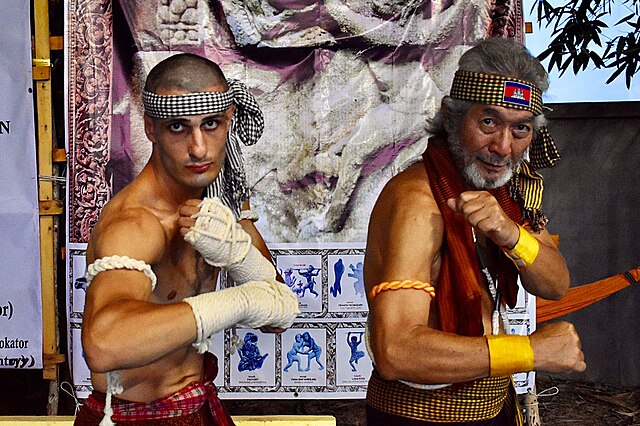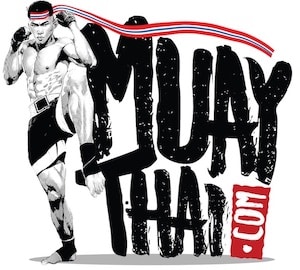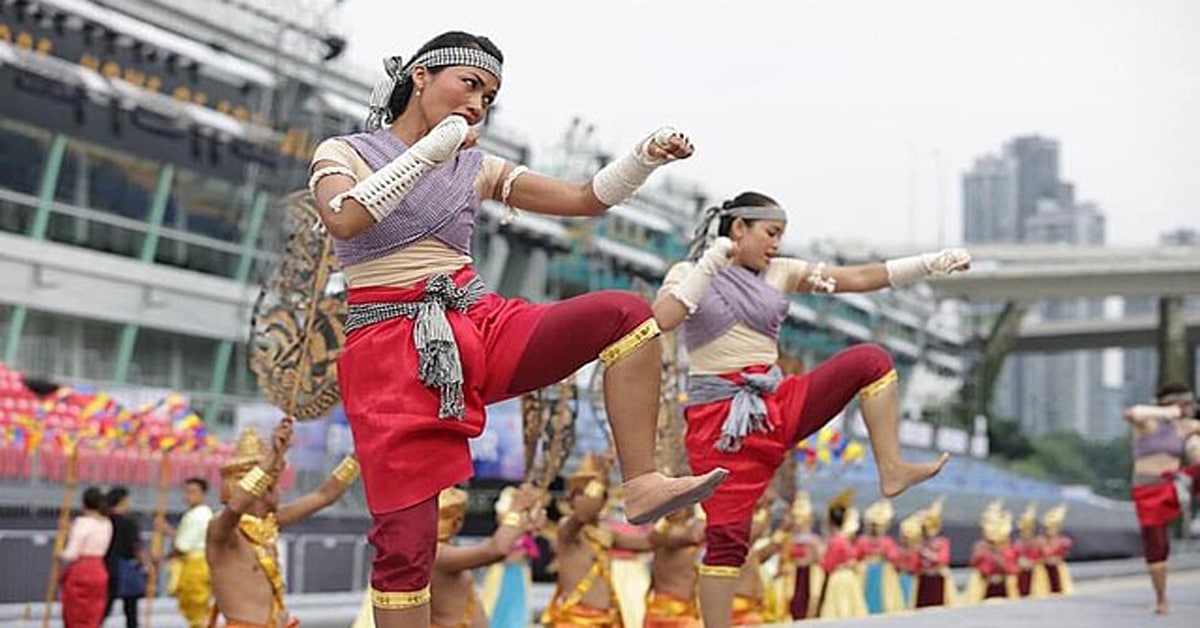Bokator – The Ancient Art of Kun Lbokator
Bokator is an ancient martial art that was used on the battlefield and was nearly put to extinction. The Cambodian-based fighting system is focused on putting an enemy to death, it is less concerned with defeating someone in the ring as a combat sport.
It directly translates in English to “Pounding a Lion.” This name comes from a legend that says a warrior defended his village from a menacing lion with nothing but a knife and his bare hands, felling the beast with a single, potent knee strike which he learned from Bokator. This story is apparently over 2,000 years old.
The name can also be related to Bokator as many of the moves in the martial art are inspired by animal movements. It also has several different styles each based on an animal.
Unlike Kun Khmer and Muay Thai, Bokator incorporates weapons into its systems plus grappling and submissions. Bokator was used by the Cambodian military in ancient times and was designed to be as deadly as possible.

Origins of Bokator
Bokator is believed to have originated more than 2,000 years ago and is closely linked to Cambodia in terms of cultural significance. The exact origins are somewhat shrouded in mystery, but it is thought to have been practiced by ancient Khmer warriors for both self-defense and in warfare.
Indian culture and philosophy deeply permeated the Angkorian society, with the grand temples of Angkor inscribed in Sanskrit and dedicated to Hindu deities like Vishnu and Shiva. Bokator practitioners to this day commence their training sessions by paying homage to Brahma. The Brahmins, known for their prominence in religious life, were adept in sword fighting and empty-hand combat techniques, and their influence is noticeable in the animal-based techniques of Bokator.
The grandeur of King Suryavarman II, who is accredited with the construction of the magnificent Angkor Wat, is captured in bas-relief murals depicting martial arts and battles, a vivid snapshot of the era 900 years past. The depictions extend to other temples like the Bayon and Banteay Chhmar, showcasing an array of Bokator techniques and the military victories of King Jayavarman VII.
The art form is depicted in bas-reliefs found on the walls of ancient temples such as Angkor Wat, suggesting its significance in the Khmer Empire. The carved reliefs depict various martial arts moves such as a rear-naked choke, spear attacks, elbow strikes, shields, kicks, knees, and more. It was much more than just a striking art.
As this was a military form of combat, the martial art was not put on display. Instead, experts and students would practice in secrecy to keep their moves a mystery from potential enemies.
Bokator vs. Kun Khmer
What’s the difference between Bokator and Kun Khmer? Kun Khmer is an archaic martial art that is focused on striking combat in a sports setting. Meanwhile, Bokator is focused on any form of combat, striking or grappling, to defeat an enemy on the battlefield.
Bokator incorporates a wide variety of techniques, including animal-inspired movements, strikes, joint locks, and submissions. It has thousands of different movements and is a comprehensive system of self-defense and combat.
Kun Khmer primarily involves stand-up striking techniques and clinching. It is based around matches that are fought in rounds, similar to boxing and Muay Thai.
Kun Khmer is far more popular in Cambodia as Bokator was nearly destroyed and almost became extinct. Kun Khmer is still active to this day with many competitions and gyms. Kun Khmer was even recognized in a South East Asia Games Tournament as an international sport. The biggest names of Kun Khmer will often compete against major names in Muay Thai.
Efforts to preserve and revive Bokator are ongoing. Grandmasters and practitioners are working to teach the new generation about this ancient art form to keep it alive. Documentaries and media coverage have also played a role in bringing attention to Bokator, leading to an increase in interest and participation. There is an effort to preserve the sport with UNESCO as well. These tasks are ongoing.

Bokator Near Extinction
During the Khmer Rouge regime (1975-1979), traditional arts, including Bokator, were suppressed. Practitioners were often targeted, leading to a significant loss of knowledge and skills. Many grandmasters and practitioners were killed or forced to hide their skills to survive.
A surviving master is Kim Sean. In an interview, he explained his efforts trying to preserve the sport. He said:
“I had dedicated my life to martial arts and was very concerned and sad when I saw Bokator was dying. I worried very much that it will get lost — thousands of years of history gone. Many Cambodians didn’t even know what it was. I knew I had to do something. This is my ultimate dream. If we get that, then my life is okay. If I die, then I can die happy. We are definitely seeing more of the country’s young taking an interest in Bokator.”
Krama
The Krama is a piece of clothing that represents the skill level of the practitioner of Bokator. It is a similar idea to the belt system found in Karate and Judo.
The Krama’s color indicates a practitioner’s rank and skill level. As students advance in their training, they earn Kramas of different colors, each marking a milestone in their journey. Obtaining a new Krama is a significant event. There are ceremonies associated with moving up the ranks.
For example, a fighter must know 100 moves to earn a white Krama. A black Krama indicates 1,000 moves. And a gold Krama is the highest level one can earn and indicates more than 10,000 moves.
The Krama is a traditional Cambodian scarf made of cotton or silk. It’s known for its checkered pattern and has been a part of Cambodian attire for centuries, not limited to martial arts. Beyond the symbolic, Kramas have practical uses. They protect the practitioner during training and can be used for various purposes.
The traditional outfit includes a krama wrapped around the waist plus the “sangvar” which are blue and red silk cords, tied around the head and biceps of the athlete. Similar to Pra Jiad, the “sangvar” is meant to bring blessing and strength to the wearer.
Styles
There are hundreds of style of Bokator, most of which is based on animal movements. Legend has it that there are greater than 300 styles of this martial art.
Lion style is the most common form. This style is rooted in the ancient legend where a warrior defeated a lion. It incorporates powerful movements to mimic the lion’s strength and agility. By training here, one would focus on strikes, blocks, and jumps, reflecting the lion’s raw power.
Snake style draws inspiration from the fluid and deadly strikes of snakes. It emphasizes fluidity, flexibility, and precision. The goal is to have quick, precise strikes targeting the opponent’s vital areas.
Monkey style is inspired by the agility, quickness, and unpredictability of monkeys. It uses rapid, acrobatic, and erratic actions to disorient opponents. Includes a variety of unpredictable strikes, grabs, and movements.
Elephant style emulates the movements of an elephant, symbolizing strength and stability. Here one would focus on slow but powerful and stable actions. It focuses on overpowering the opponent with sheer force.
There is also horse style which is inspired by the strength and speed of the horse. With horse style, one would use quick, forward-moving actions with a focus on stability and ground coverage. Charging attacks and powerful kicks are common.
Bokator includes styles based on many other animals like the crocodile, deer, and cat. Each has unique movements and techniques reflective of the respective animal’s characteristics.
The overall martial art focuses on both stand-up striking and submission grappling. It is trying to stop an enemy as quickly as possible. Knees and elbows are commonly used in addition to clinching and joint manipulation.
There is hand-to-hand combat plus the weapons-based system in Bokator. Figures are often depicted using a long staff, spear, bamboo sticks, shields, lotus sticks, and “trabiet,” which is a rice farming tool.
Bokator is not meant to be used in a ring. It is a battlefield martial art focused on killing an opponent as quickly as possible. In terms of philosophy, one would find similarities between this Cambodian martial art system and Muay Boran.
Similarly, Muay Boran is an ancient martial system used by the military. However, legends date back further for Bokator.
Final Thoughts
Bokator is an ancient Cambodian martial art characterized by its animal-inspired techniques, with practitioners mimicking the movements of various animals such as lions, birds, and snakes.
Its name, derived from “labokatao” meaning “to pound a lion,” has historical connections to a legend dating back 2,000 years. The art form is deeply ingrained in Cambodia’s culture and history. One can enjoy the bas-reliefs in ancient temples like Angkor Wat.
Practitioners wear a Krama, a type of scarf, which signifies their level of expertise, akin to the belt system in other martial arts. Despite facing near extinction during the Khmer Rouge era, efforts to revive and preserve Bokator continue, and it remains a significant aspect of Cambodia’s cultural heritage.

